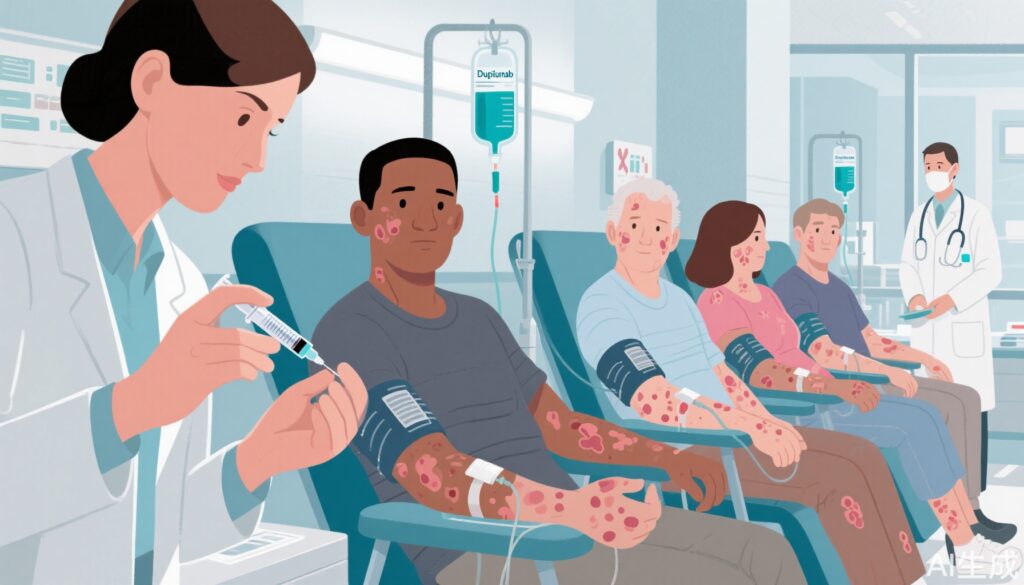Highlights
- Dupilumab led to higher complete response rates and fewer discontinuations of cancer therapy compared to systemic steroids for ADC-induced dermatologic adverse events.
- Patients receiving dupilumab showed rapid improvement, with a median time to first clinical response of 24 days.
- No patients in the dupilumab group discontinued cancer therapy due to skin toxicities, compared to 43.8% in the steroid group.
- Dupilumab offers a promising steroid-sparing approach for managing challenging cutaneous reactions in cancer patients on ADCs.
Clinical Background and Disease Burden
Antibody-drug conjugates (ADCs) have transformed the landscape of targeted cancer therapy, offering improved efficacy for malignancies such as genitourinary cancers. However, their use is frequently complicated by dermatologic adverse events (dAEs) like eczematous, morbilliform, and vesiculobullous eruptions. These cutaneous toxicities can be severe, impact quality of life, and often lead to dose reductions or discontinuation of potentially life-saving cancer therapy. Traditional management relies heavily on systemic corticosteroids, which carry their own risks, especially in immunocompromised cancer patients. Thus, there is a significant unmet need for effective, steroid-sparing management of ADC-induced skin toxicities that allows patients to maintain optimal oncologic treatment.
Research Methodology
Researchers at Memorial Sloan Kettering Cancer Center conducted a retrospective cohort analysis of 163 patients treated with ADCs between January 2020 and September 2024. After screening, 27 adult patients who developed ADC-induced dAEs were included. Eleven patients (63.6% women, 81.8% White) received dupilumab, an interleukin-4 receptor alpha antagonist approved for atopic dermatitis and other Th2-mediated diseases. Sixteen patients (37.5% women, 81.2% White) received systemic corticosteroids alone. The majority in both groups were treated for genitourinary malignancies with enfortumab vedotin, some in combination with pembrolizumab. Outcomes assessed included severity of dAEs (graded per CTCAE), clinical response (complete or partial), time to response, and rates of cancer treatment discontinuation due to skin toxicity.
Key Findings
In the dupilumab group, 82% of patients received enfortumab vedotin, and 46% received pembrolizumab. Dermatologic manifestations included eczematous (54%), morbilliform (46%), and vesiculobullous (27%) eruptions. Notably, 70% of dupilumab recipients experienced grade 3 skin events (severe), compared to 56% experiencing grade 2 reactions in the steroid group. Despite the higher baseline severity, dupilumab was associated with:
- A higher rate of complete clinical response: 73% vs. 56% (dupilumab vs. steroids)
- Partial response rates were similar: 27% vs. 25%
- Median time to first response: 24 days (dupilumab group)
- Median time to best clinical response: 52 days (dupilumab group)
- No discontinuation of cancer therapy due to skin AEs in the dupilumab group, compared to 43.8% in the steroid group (statistically significant, P < .05)
These findings underscore dupilumab’s potential to not only control skin toxicity but also to allow patients to continue their critical cancer regimens without interruption.
| Outcome | Dupilumab (n=11) | Systemic Steroids (n=16) |
|---|---|---|
| Complete Response (%) | 73 | 56 |
| Partial Response (%) | 27 | 25 |
| Median Time to First Response (days) | 24 | Not specified |
| Discontinuation Due to dAEs (%) | 0 | 43.8 |
Mechanistic Insights and Biological Plausibility
Dupilumab targets the IL-4/IL-13 pathway, central to Th2-mediated inflammation. ADC-induced eruptions often share features with atopic dermatitis, suggesting a shared pathogenic pathway. By modulating this axis, dupilumab may effectively control inflammatory skin manifestations without the broad immunosuppression associated with systemic steroids, providing a mechanistically rational and potentially safer alternative.
Expert Commentary
The authors of the study noted that “dupilumab appears promising as a steroid-sparing treatment of ADC-induced cutaneous toxicities, which are difficult to manage and can disrupt cancer treatment.” They emphasized the importance of further research to validate these findings in larger, more diverse populations and to assess the cost-effectiveness of routine dupilumab use in this context. Current guidelines for oncologic supportive care do not yet address biologic therapies for ADC-induced dAEs, but this study may prompt future updates.
Controversies and Limitations
Key limitations include the small sample size and retrospective single-center design, limiting generalizability. The higher baseline severity of dAEs in the dupilumab group may introduce confounding, although the observed benefit despite this suggests robust efficacy. The study population was predominantly White and treated for genitourinary cancers, so applicability to other ethnicities and tumor types requires further validation. Cost and insurance coverage for off-label dupilumab use remain practical barriers.
Conclusion
This study highlights dupilumab as a promising, steroid-sparing therapy for managing ADC-induced dermatologic toxicity, enabling patients to maintain life-prolonging cancer therapy with fewer interruptions. The evidence supports further prospective trials and potentially guideline inclusion. Future research should address broader patient populations, mechanistic underpinnings, and economic feasibility.
References
1. Nykaza I, Dusza SW, Rosenberg JE, et al. Use of Dupilumab to Manage Antibody-Drug Conjugate-Induced Cutaneous Toxicities. JAMA Dermatol. 2025 Jul 30. doi: 10.1001/jamadermatol.2025.2567.
2. Lacouture ME, Sibaud V, Anadkat MJ, et al. Dermatologic toxicities associated with antibody-drug conjugates in oncology: recognition and management. J Am Acad Dermatol. 2021;85(2):319-332.
Case Vignette
Ms. Linda Carter, a 62-year-old with metastatic urothelial carcinoma on enfortumab vedotin and pembrolizumab, developed severe eczematous skin eruptions. Initiation of dupilumab led to rapid improvement without the need for systemic steroids, allowing uninterrupted cancer therapy. This mirrors the real-world benefits observed in the study cohort.


